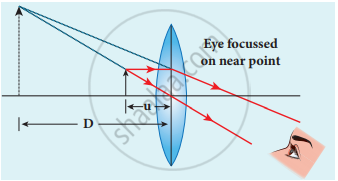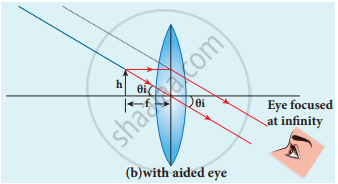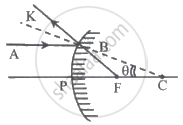Advertisements
Advertisements
प्रश्न
Discuss about simple microscope and obtain the equations for magnification for near point focusing and normal focusing.
उत्तर
- A simple microscope is a single magnifying (converging) lens of small focal length The idea is to get an erect, magnified and virtual image of the object.
- Near point focusing –
The image is formed at near point, i.e. 25 cm for normal eye. This distance is also called as least distance D of distinct vision. In this position, the eye feels comfortable but there is little strain on the eye. - Normal focusing –
The image is formed at infinity. In this position the eye is most relaxed to view the image.
> Object distance u is less than f. The image distance is the near point D. The magnification m is given by the relation,
m = `"v"/"u"` - With the help of lens equation,
`1/"v" − 1/"u" = 1/"f"` the magnification can further be written as,
m = 1 – `"v"/"f"` - Substituting for v with sign convention,
v = -D - m = `1 + "D"/"f"`
This is the magnification for near-point focusing.
Near point focusing - The angular magnification is defined as the ratio of angle θi subtended by the image with an aided eye to the angle θ0 subtended by the object with the unaided eye.
m = `theta_"i"/theta_0`

Normal focusing - For unaided eye shown in Figure (a),
tan θ0 ≈ θ0 = `"h"/"D"` - For aided eye shown in Figure (b),
tan θi ≈ θi = `"h"/"f"` - The angular magnification is,
m = `θ_"i"/θ_0` = `("h"//"f")/("h"//"D")`
m = `"D"/"f"`
This is the magnification for normal focusing.
APPEARS IN
संबंधित प्रश्न
Answer the following question in detail.
Derive an expression for the magnifying power of a simple microscope. Obtain its minimum and maximum values in terms of its focal length.
Answer the following question in detail.
Obtain the expressions for magnifying power and the length of an astronomical telescope under normal adjustments.
Answer the following question in detail.
What is the limitation in increasing the magnifying powers of the astronomical telescope?
What is the near point focusing?
What are the uses of spectrometer?
What is the remedy of myopia?
What is presbyopia?
Discuss about astronomical telescope.
Mention different parts of the spectrometer.
A compound microscope has a magnifying power of 100 when the image is formed at infinity. The objective has a focal length of 0.5 cm and the tube length is 6.5 cm. What is the focal length of the eyepiece.
The near point and the far point for a person are 50 cm and 500 cm, respectively. Calculate the power of the lens the person should wear to read a book held in hand at 25 cm. What maximum distance is clearly visible for the person with this lens on the eye?
A light wave of wavelength λ is incident on a slit of width d. The resulting diffraction pattern is observed on a screen at a distance D. If linear width of the principal maxima is equal to the width of the slit, then the distance D is
When a convex lens of 12.5 cm focal length is used as a magnifying glass, normal eye can see an object clearly at a distance of 25 cm. The magnifying power of the instrument is ____________.
If astronomical telescope of length 1.53 m has magnifying power of magnitude 50, the values of fo and fe are ____________.
The speed of light in media 'A' and 'B' are 2.0 × 1010 cm/s and 1.5 × 1010 cm/s respectively. A ray of light enters from medium B to A at an incident angle 'θ'. If the ray suffers total internal reflection, then ______.
An observer looks at a distant tree of height 10 m with a telescope of magnifying power of 20. To the observer the tree appears:
The image formed by an objective of a compound microscope is ______.
In the adjoining figure, AB represents the incident ray, and BK is the reflected ray. If angle BCF = θ, then ∠BFP is given by ______.

